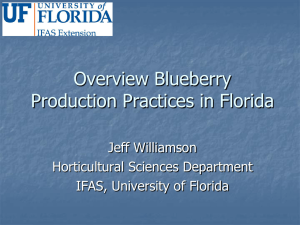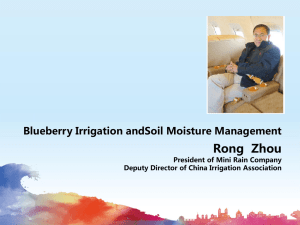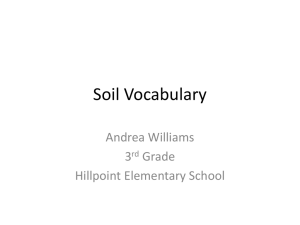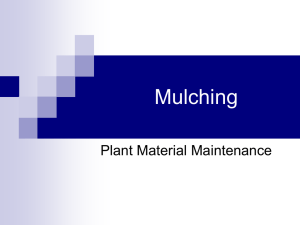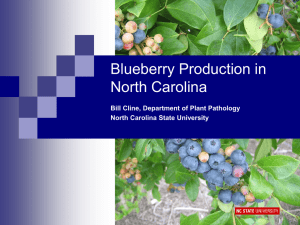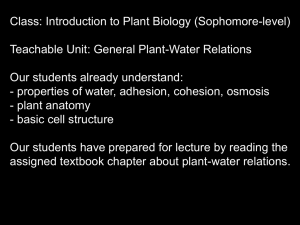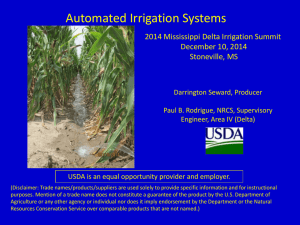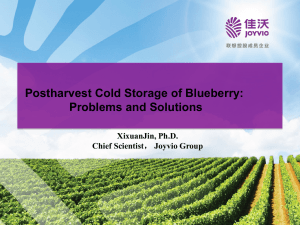Water Use of Southern Highbush Blueberry (PowerPoint)
advertisement
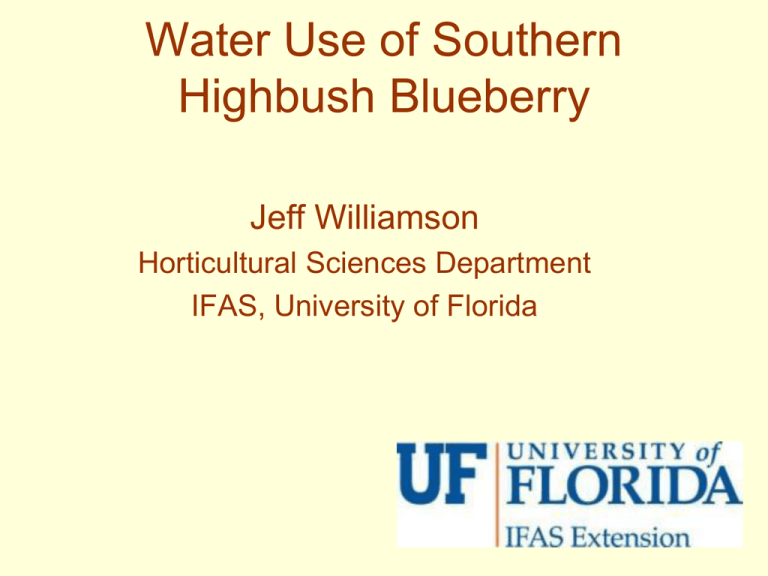
Water Use of Southern Highbush Blueberry Jeff Williamson Horticultural Sciences Department IFAS, University of Florida Pine Bark Culture Pine Bark Culture • Bark beds are currently one of the common methods for growing SHB. • Pine bark increases organic matter, decreases soil pH, maintains N in NH4 form. Before planting Newly planted blueberry field on pine bark beds in Florida Newer system – bark incorporated into soil with ground cloth and drip irrigation Examples of SHB production systems Bark incorporated into soil Bark beds Incorporated bark with ground cloth Pine bark increases organic matter, decreases soil pH, maintains N in NH 4 form, While overhead irrigation is still needed for freeze protection, most new plantings are low-volume, usually drip or drip with ground cover. Excavated Blueberry Plant Root system was only a few inches deep The bark bed and root system was easily separated from soil with very few roots located in the underlying soil Blueberry roots at three soil depths for two soil treatments Soil depth (inches) 0 to 3.5 4 to 7.0 7.5 to 10.5 Soil treatment Percent of total roots Bark bed 44 Bark incorporated 46 Bark bed 37 Bark incorporated 45 Bark bed 19 Bark incorporated 8 Plant water potential during the fruit ripening period - 2010 OBJECTIVES • The objective of this study was to evaluate plant drought stress during the final stages of fruit development of blueberry grown in several soil management systems without irrigation. MATERIALS AND METHODS • Predawn and solar noon plant water potential of ‘Emerald’ SHB was measured with a pressure chamber during a dry period of fruit development and no irrigation was applied. Drought - Predawn 2010 0 Irrigation was shut off kilopascals (kPa) -200 b b b a -400 Incor.+Mulch. -600 b b b a Bed b ab ab Incorpor. -800 Soil 5/10 a 5/11 5/12 5/13 Date 5/14 5/15 5/16 Drought - Solar Noon + 2 hours 2010 -1000 kilopascals (kPa) -1200 -1400 b b b a Irrigation was shut off b b b b b b a -1600 b b b a Incor.+Mulch. -1800 a Bed b ab ab a b ab ab Incorpor. -2000 Soil 5/10 5/11 a 5/12 5/13 Date 5/14 5/15 5/16 Preparing holes for lysimeters Bark or soil/bark mixture added Transplanting blueberry plant Plant positioned above lysimeter December, 2009 June, 2011 December, 2011 Plant canopy volume (yd3) June 2010 Aug 2010 June 2011 After pruning Dec. 2011 Dec 2012 B 2.36 1.64 3.73 2.03 2.45 3.52 B+S 2.03 1.85 3.08 2.05 2.35 3.57 1x/day 2.11 1.64 3.26 2.05 2.32 3.32 2x/day 2.27 1.86 3.55 2.03 2.48 3.77 Treatme nt Soil Irr. freq. Berry yield (lbs./plant) in 2011 and 2012 Treatment 2011 2012 Bark 17.7 11.3 B+S 15.3 10.2 Once/day 16.6 8.9 Twice/day 16.6 12.5 Soil Irrigation Daily plant water use of mature ‘Emerald’ blueberry plants by month averaged across treatments and years. Gallons.plant-1.day-1 2.5 2 1.5 1 0.5 0 Jan* Feb* Mar Apr May Jun Jul Aug Sep Oct Nov Dec Monthly means + SE of daily water use of mature ‘Emerald’ southern highbush blueberry plants averaged across treatments and years from April, 2010 to Sept. 2012. *Means for one year due to complications from overhead irrigation for freeze protection. 2.5 Gallons/plant/day Harvest 2 Pruned 1.5 1 0.5 Mean 0 16-Apr 1-May 16-May 31-May 15-Jun 30-Jun 15-Jul 30-Jul Monthly crop coefficients (Kc) for mature ‘Emerald’ blueberry plants Averaged across treatments and years from April, 2010 to Sept. 2012 1 Overall means 0.9 Crop coefficient (Kc) 0.8 0.7 0.6 0.5 0.4 0.3 0.2 0.1 0 Jan* Feb* Mar Apr May Jun Jul Aug Sep Oct Nov Dec Monthly Kc means + SE for mature ‘Emerald’ southern highbush blueberry plants averaged across treatments and years from April, 2010 through September, 2012. Kc values are based on 3 ft. in-row by 10 ft. between row plant spacing (1452 plants/a.). *Mean for one year due to complications from overhead irrigation for freeze protection. Mean annual Kc = 0.65. Estimated per acre water use of mature ‘Emerald’ blueberry plants at 3’ by 10’ spacing (1452 plants/a) Jan Feb Mar Apr May Jun July Aug Sep Oct Nov Dec gal/day 625 1452 2091 2265 2875 2643 2846 3151 2686 1888 1496 842 gal/month 19,375 40,656 64,821 67,950 89,125 79,290 88,226 97,681 80,580 58,528 44,880 26,102 Yearly water use = 757,214 gal. per acre or 27.88 acre-inches in the planted field. Assuming 4 ft. wide beds with 10 ft. row spacing ≈ 69.71 inches in the row bed (area with root system). Conclusions • Southern highbush blueberry plants are shallow-rooted and drought susceptible. 80+% of roots were in the top 7 inches of soil. • Frequent, light, irrigations are needed during the growing season. • Bark, applied as either a bed or incorporated into the soil reduced drought stress. • Regardless of soil treatment, plant water stress increased significantly after 3 days without irrigation. Conclusions • Monthly averages for daily plant water use of mature ‘Emerald’ blueberry plants ranged from about 0.6 gal/day (winter) to over 2 gallons/day (mid to late summer). • Water demands increased rapidly in the spring (March) and peak water demands occurred during the late stages of fruit development (late April and May) and in mid to late summer (July – Sept.). Maximum monthly averages ≈ 2.0 – 2.25 gal./plant/day. • Monthly averages do not reflect the day to day variation in water demand which is heavily influenced by weather and can be considerably greater or less than the monthly averages. • Summer pruning significantly reduced plant water use for 3 to 4 weeks until plant canopies were re-established. • Kc values can be used with reference ET to determine general water requirements. Soil moisture monitoring devices along with a knowledge of rooting depth, distribution, and soil water holding characteristics are useful when developing irrigation schedules. Acknowledgements Southwest Florida Water Management District Florida Blueberry Growers Association Luis Mejia, graduate student, Horticultural Sciences Department, IFAS, UF Bradley Ferguson, graduate student, Horticultural Sciences Department, IFAS, UF Paul Miller, former biologist, Horticultural Sciences Department, IFAS, UF Eric Ostmark, biologist, Horticultural Sciences Department, IFAS, UF Thank You! Questions?
